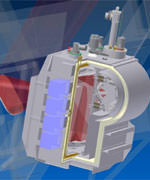
Image credit: PPARC
The Canadian Federation for Innovation announced today that it will be contributing $12.3 million CDN for the development of the SCUBA 2 project – an instrument that will be able to detect objects in the sub-millimetre wavelengths (in between radio and infrared). SCUBA 2 will be faster, imaging objects in hours instead of weeks, and it will be much more sensitive, allowing it to look further into space. Sub-millimetre astronomy is a newer field of research, which allows astronomers to penetrate clouds of obscuring dust to look at comets, the birthplace of stars, and distant galaxies.
Astronomers are poised to take another giant leap into some of the coldest regions of space following the announcement that Canada will join the UK in developing a new generation camera for the James Clerk Maxwell Telescope (JCMT) in Hawaii – the world’s largest telescope for studying astronomy at sub-millimetre wavelengths.
The announcement today (26 September 2003) of a grant of ?5.5 million (12.3 million Canadian Dollars) from the Canadian Foundation for Innovation will contribute to the development of a new instrument, SCUBA 2. The UK, through the Particle Physics and Astronomy Research Council (PPARC) will also contribute some ?4 million to the development of the instrument with a further ?2.3 million coming from the JCMT partner Agencies contributions (UK, Canada and the Netherlands).
The project is lead by the UK Astronomy Technology Centre (UK ATC) at the Royal Observatory, Edinburgh. The new instrument will supersede the original groundbreaking Sub-millimetre Common User Bolometer Array (SCUBA) frequently cited as one of the most important ground-based astronomical instruments ever. SCUBA was also designed and constructed at the Royal Observatory, Edinburgh in collaboration with Queen Mary, University of London.
Professor Ian Halliday, Chief Executive of PPARC commented “SCUBA 2 will enable the JCMT to maintain its position as one of the world’s leading facilities in the exotic field of sub-millimetre astronomy. We are delighted that our Canadian colleagues have joined with us to spearhead its development.”
Dr Wayne Holland, SCUBA 2 Project scientist at the UK ATC said “To work in this challenging field requires special techniques and cutting-edge technology. With a much larger field of view and the capability to limit background ‘noise’, SCUBA 2 will map large areas of sky up to 1000 times faster than the current SCUBA camera. Sub-millimetre detectors must be cooled to a fraction of a degree above absolute zero (-273 decrees C). The UK ATC has considerable experience of producing electrical and optical systems that deliver a high level of performance at these extreme temperatures.”
Dr Adrian Russell, Director of the UK ATC said: “SCUBA 2 will be a second revolution in sub-millimetre astronomy and will build on the ground-breaking science that its predecessor SCUBA (1) has already delivered. The JCMT community will have access to a tremendously powerful tool which will not only carry out world class science, but will put them in an enviable position to exploit the new ALMA telescope when it comes online. ”
Sub-millimetre astronomy is a new and rapidly developing field that allows scientists to probe the composition of comets, the birthplaces of stars and the most distant galaxies. Sub-millimetre wavelengths lie between those of traditional radio astronomy and those of the newer but now fairly well understood infrared astronomy. Astronomers detect light at sub-millimetre wavelengths in order to penetrate clouds of cosmic dust.
The vast majority of light from young galaxies in the distant universe is absorbed by dust, and is only observable by astronomers at sub-millimetre wavelengths. The quantity of dust in young galaxies reveals whether stars formed gradually, or mainly in sudden bursts, in the early history of the Universe.
SCUBA 2 will actually have two cameras – each operating simultaneously at a different wavelength in the sub-millimetre band. The 6400 pixels in each camera will cover an 8 x 8 arc-minute patch of sky (about a third of the full moon) or some 16 times the area of the existing SCUBA instrument. The improved sensitivity and imaging power will mean that observations that now take weeks of telescope time with SCUBA will be made in only a few tens of minutes.
Original Source: PPARC News Release
